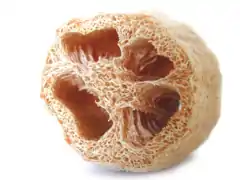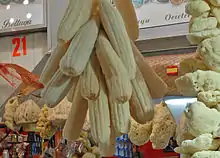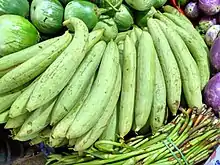Luffa aegyptiaca
Luffa cylindrica, the sponge gourd,[2] Egyptian cucumber or Vietnamese luffa, is an annual species of vine cultivated for its fruit, native to South and Southeast Asia.
| Luffa aegyptiaca | |
|---|---|
 | |
| Egyptian luffa fruit | |
| Scientific classification | |
| Kingdom: | Plantae |
| Clade: | Tracheophytes |
| Clade: | Angiosperms |
| Clade: | Eudicots |
| Clade: | Rosids |
| Order: | Cucurbitales |
| Family: | Cucurbitaceae |
| Genus: | Luffa |
| Species: | L. aegyptica |
| Binomial name | |
| Luffa aegyptica | |
| Synonyms[1] | |

Etymology
The synonymous botanical specific epithet "aegyptiaca" was given to this plant in the 16th century when European botanists were introduced to the plant from its cultivation in Egypt. In the European botanical literature, the plant was first described by Johann Veslingius in 1638, who named it "Egyptian cucumber". Veslingius also introduced the name "Luffa".[3]
Description and cultivation
The fruit, approximately 30 cm (12 in) long, resembles a cucumber in shape and size. Owing to its striking yellow flowers, Luffa cylindrica is occasionally grown as an ornamental.
Luffa cylindrica is best grown with a trellis support.[4] It requires much heat and much water to thrive.
Uses
The young fruit is eaten as a vegetable and is commonly grown for that purpose in tropical Asia. Unlike the young fruit, the fully ripened fruit is strongly fibrous and inedible, and is used to make scrubbing bath sponges. Due to the use as a scrubbing sponge, it is also known by the common names dishrag gourd, rag gourd, sponge gourd, and vegetable-sponge.[1] It is also called smooth luffa to distinguish it from the ridged luffa (Luffa acutangula), which is used for the same purposes.[1]
An edible oil can be extracted from the seeds. The resulting oil meal can be fed to rabbits and catfish, or used as a fertilizer.[5]
 The fibrous skeleton of the fruit is used as a household scrubber. The fiber is xylem. It has semi-coarse texture and good durability. |
 Sponges made of sponge gourd for sale alongside sponges of animal origin (Spice Bazaar at Istanbul, Turkey). |
 Sponge gourd in a market in Dhaka, Bangladesh. |
| Nutritional value per 100 g (3.5 oz) | |
|---|---|
| Energy | 56 kJ (13 kcal) |
14.34 g | |
| Sugars | 5.17 g |
| Dietary fiber | 2.9 g |
0.34 g | |
0.66 g | |
| Vitamins | Quantity %DV† |
| Vitamin A | 260 IU |
| Thiamine (B1) | 4% 0.046 mg |
| Riboflavin (B2) | 4% 0.042 mg |
| Niacin (B3) | 2% 0.26 mg |
| Vitamin B6 | 8% 0.099 mg |
| Folate (B9) | 3% 12 μg |
| Vitamin C | 7% 5.7 mg |
| Vitamin E | 2% 0.24 mg |
| Vitamin K | 2% 1.7 μg |
| Minerals | Quantity %DV† |
| Calcium | 1% 9 mg |
| Iron | 3% 0.36 mg |
| Magnesium | 6% 20 mg |
| Phosphorus | 4% 31 mg |
| Potassium | 10% 453 mg |
| Sodium | 1% 21 mg |
| Zinc | 2% 0.17 mg |
| |
| †Percentages are roughly approximated using US recommendations for adults. Source: USDA FoodData Central | |
In art
In Israel, Luffa cylindrica has been in use since the time of the Late Roman Empire. Young fruits were used for food. Mature fruits were used as bath sponges. Luffa cylindrica fruits were decorated for the first time in art of the Byzantine era in Israel only. The fruits were decorated on mosaics of churches and synagogues in Israel.
 Luffa in Kursi mosaic, Golan Heights |
 Luffa in mosaic at Beth Alfa synagogue |
|---|
References
- "Luffa aegyptiaca". Germplasm Resources Information Network (GRIN). Agricultural Research Service (ARS), United States Department of Agriculture (USDA). Retrieved 21 December 2017.
- "Luffa aegyptiaca". Natural Resources Conservation Service PLANTS Database. USDA. Retrieved 23 June 2015.
- Johann Veslingius, De Plantis Aegyptiis, 1638. p. 48 (in Latin)
- A Legacy of Luffa, by Elizabeth Harwick, who grows Luffa cylindrica successfully in South Carolina.
- Heuzé V., Tran G., Lebas F., 2017. Luffa (Luffa aegyptiaca). Feedipedia, a programme by INRA, CIRAD, AFZ and FAO. https://www.feedipedia.org/node/626 Last updated on July 18, 2017, 10:53
External links
| Wikimedia Commons has media related to Luffa aegyptiaca. |
- Luffa aegyptiaca at Floridata
- Multilingual taxonomic information at the University of Melbourne
- Luffa.info: Info on growing and using Luffa cylindrica as a scrubbing sponge
- Anat Avital and Harry S. Paris, 2014, 'Cucurbits depicted in Byzantine mosaics from Israel, 350–600 CE', Annals of Botany 114: pp. 203-22
- Dressler, S.; Schmidt, M. & Zizka, G. (2014). "Luffa aegyptiaca". African plants – a Photo Guide. Frankfurt/Main: Forschungsinstitut Senckenberg.